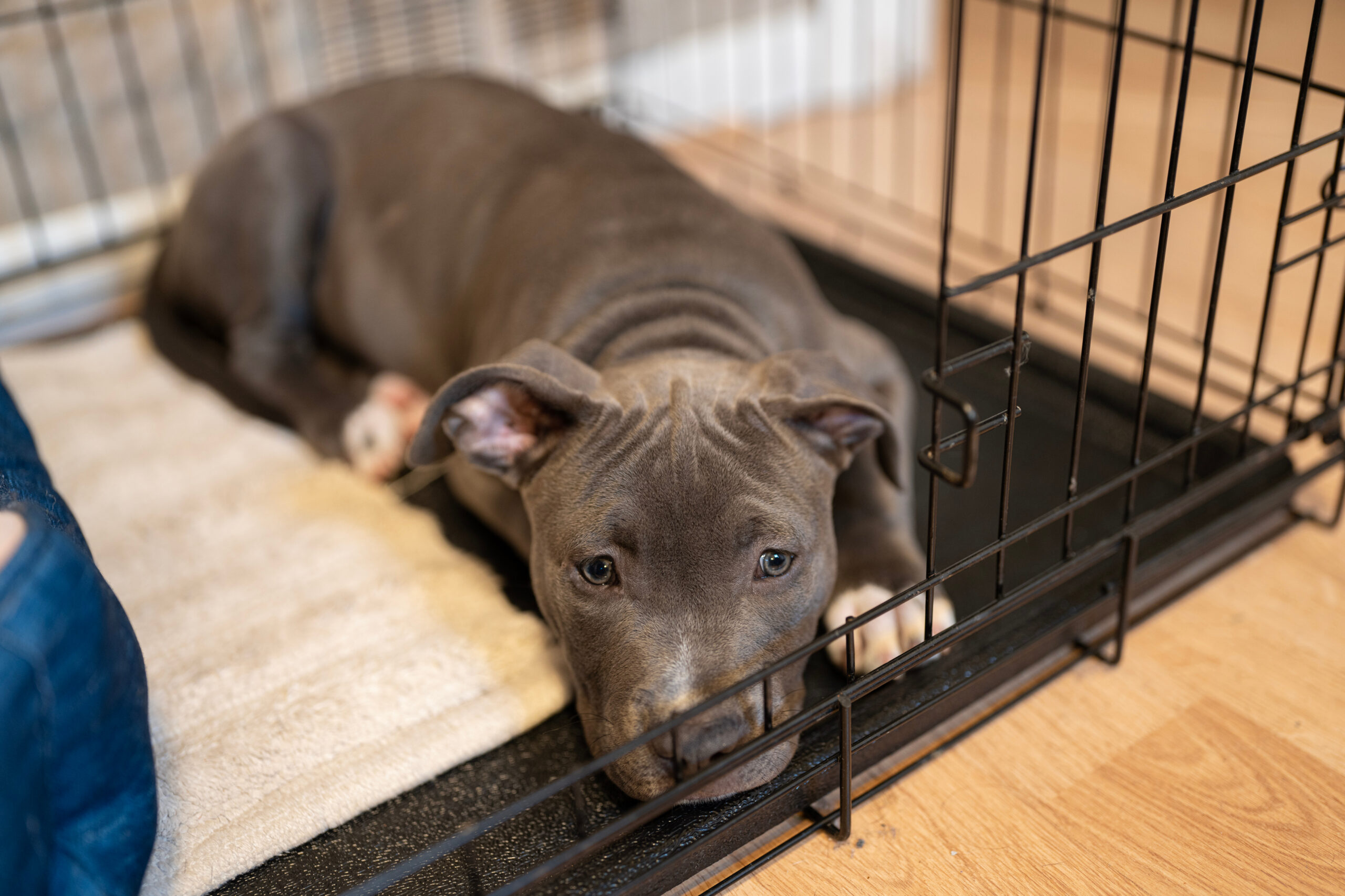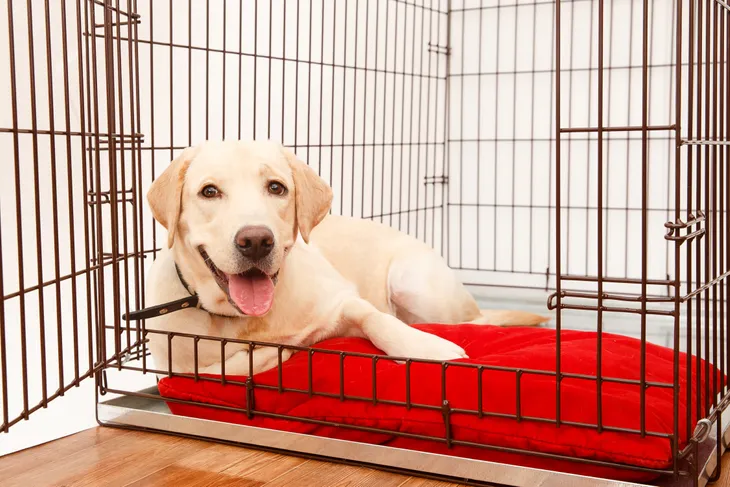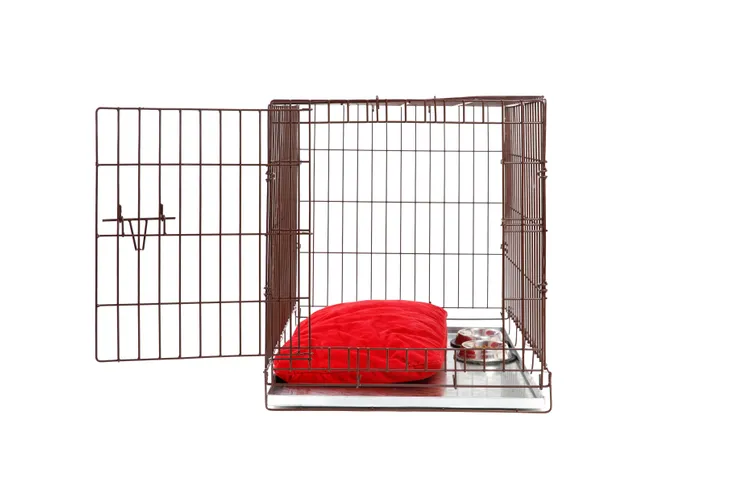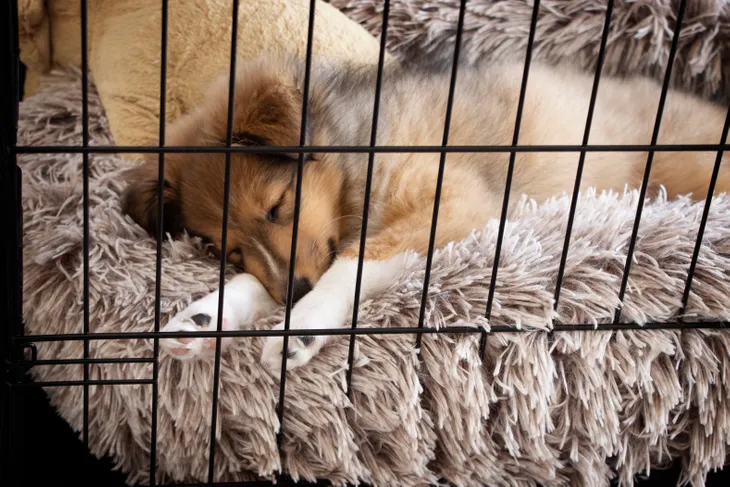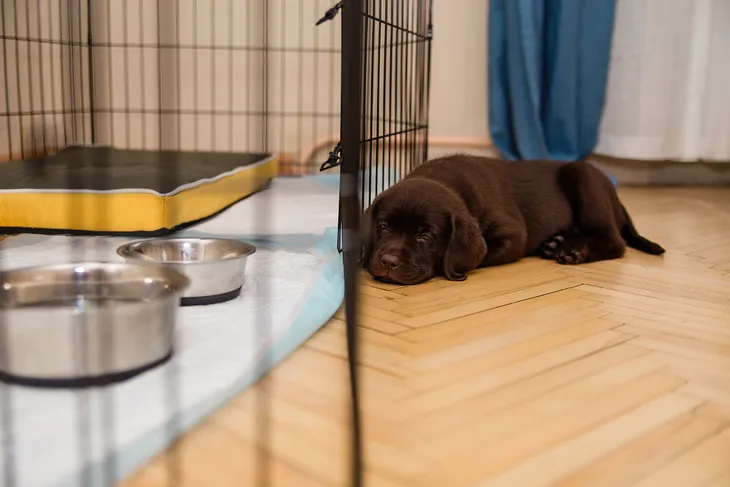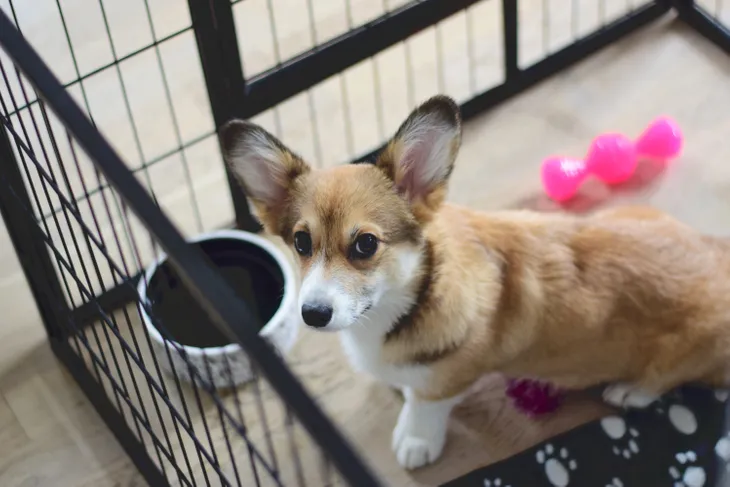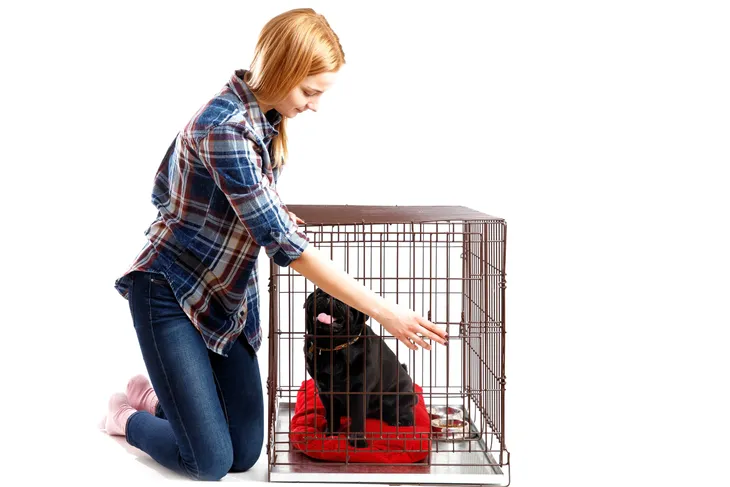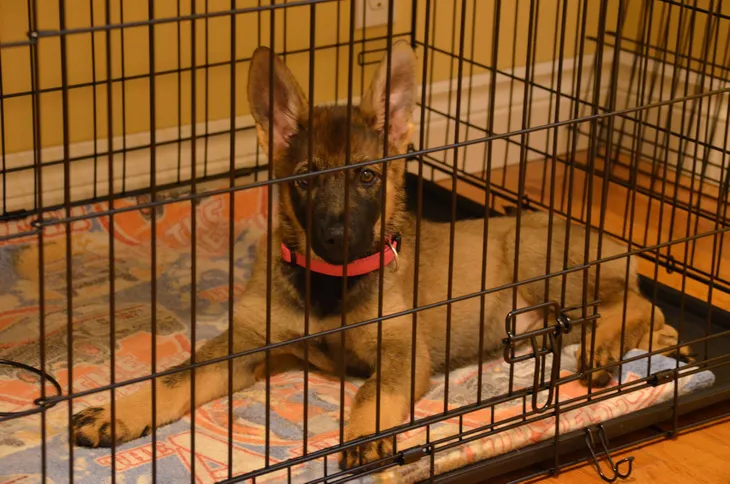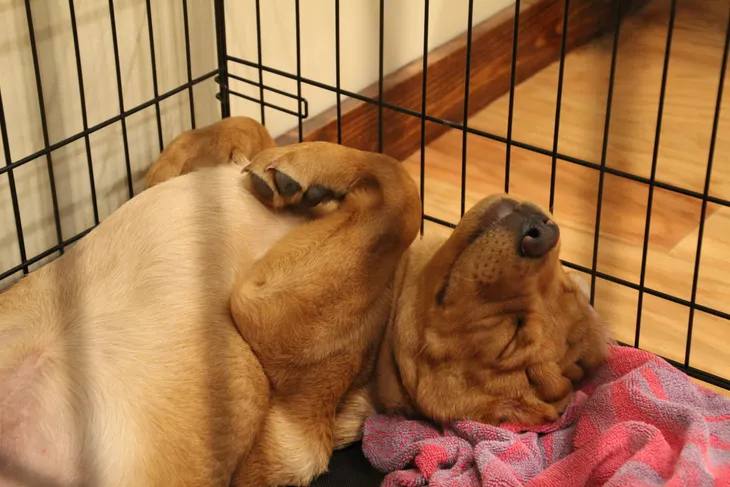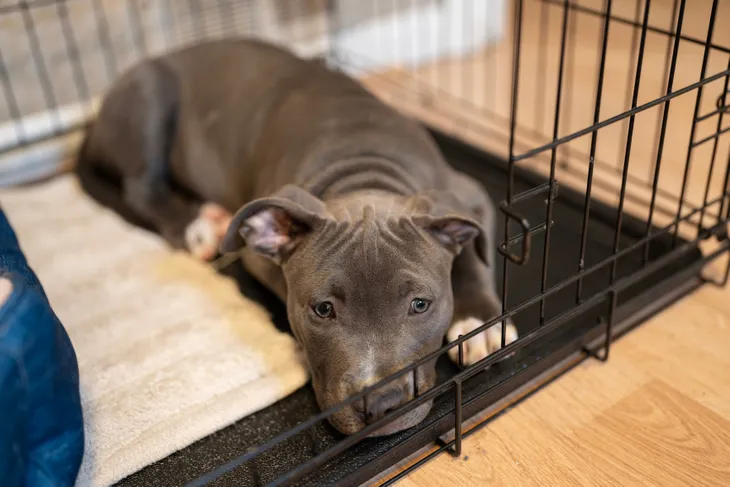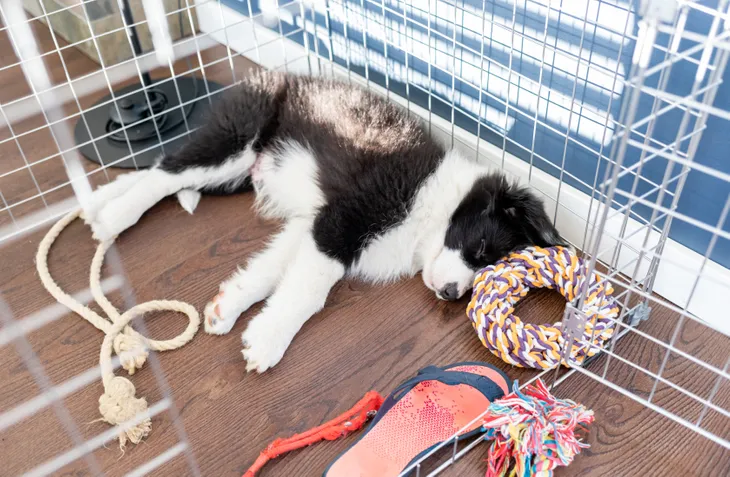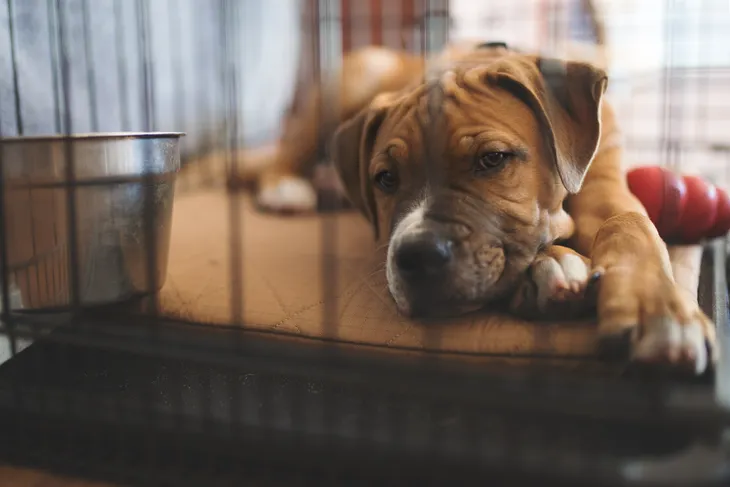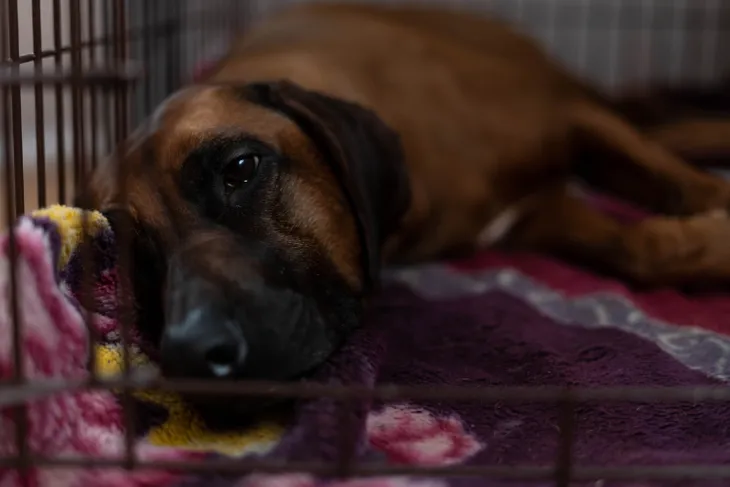- Crate training is not only a helpful tool for potty training puppies, it also prevents property damage, keeps the dog safe, and provides them with their own personal space.
- There are 5 important steps in the crate training process. Take it slow. Don’t move to the next stage until they are fully comfortable at their current level.
- It is the owners responsibility to crate train as humanely as possible. Never use a crate as punishment, force a dog into their crate, or leave them crated for extended periods of time.
Becoming a pet owner is a big and exciting decision that comes with a lot of responsibility. No matter how old the puppy is, size, gender, or breed — proper training is key. While not everyone decides to crate train their puppy, it’s a great tool for pet owners to use to keep their dog safe and out of trouble, while also providing a quiet personal space for their pet.
Dogs are den animals which means they like to have their own enclosed space to rest, take a nap, or even hide, explains PetMD. It’s part of their natural instinct to seek out a den-like area that is all their own. This isn’t to say crate training is easy peasy. It takes a lot of work, but the results can be wonderful for both owners and their pets. For those who are interested, here’s a guide with everything to know about crate training your puppy…
Benefits of Crate Training
According to VCA Canada, “contentment during confinement is an important life skill for puppies and dogs.” One of the biggest benefits is that it keeps our animal safe when they are left unsupervised. A puppy that is left to roam the house will not only likely cause property damage and have potty training mishaps, it could also be harmful to the dog. They could eat dangerous items around the house or escape from the property.
They are a great tool for keeping dogs separate from visiting guests or workers to the home. It provides the puppy with a safe place to sleep undisturbed, whether that is at night or if they’d like some quiet time during the day. Most veterinarians, groomers, boarders or vacation camps use them so it’s beneficial for a dog to already be used to them. If you plan on traveling they’ll need to be accustomed to a crate. Crates are also a very useful tool when it comes to potty training a puppy.
When Should I Start Crate Training?
You can start crate training at any age, but the earlier the better. Most veterinarians, trainers and breeders recommend crate training dogs from a young age, explains the American Kennel Club. “Crate training is an essential part of housebreaking puppies, as dogs don’t like to soil their sleeping quarters,” writes the source. “They learn to hold their bladder while they’re in their crate, so you won’t have to clean up messes.”
While a dog can be crate trained at any age, starting during the puppy stage is preferred. Not only does it assist with potty training, but crate training an older dog can cause unnecessary stress. “When older dogs are dealing with illnesses like incontinence, arthritis, or canine cognitive dysfunction,” they don’t need the additional stress of trying to learn a new skill, says the American Kennel Club. When they are older and in need of a safe place to rest their joints or take frequent naps, the crate will be a safe haven for them. It also makes transporting them much easier and safer.
How to Choose the Right Crate
There are many different options available — from plastic, to fabric and even collapsible metal crates. Plus, they come in all different sizes for a wide range of prices. Some crates adjust in size as the dog grows, while others are geared toward mobility and travel. You can find them at most pet supply stores and websites.
The most important thing to consider is size. Your puppy is small now, but they will grow! If the dog is from a breed that grows quite large, get an adjustable crate that will eventually fit their adult size. For reference, the dog needs to be able to stand up, turn around, and lie down comfortably.
On the other hand, don’t buy a crate that is too big. It might seem like a nice thing to do, but they’ll likely end up using a corner as a bathroom when left alone for long periods of time.
Make it Cozy and Comfortable
First step is to make it a comfortable space. You can put an old blanket or comfortable dog bed inside. When looking for a place to put the crate, make sure it’s not too far from people, but also not right in the middle of the room. Find a quiet corner in a main room of the house. Drape a blanket overtop to make it feel more cozy and enclosed.
To make the crate a more comfortable space, put a soft bed or blanket in there. If they start chewing these items, take them away. You don’t want them to become a potential hazard for your pet.
Step 1: Introduce Your Dog to the Crate
Before starting, remember the crate is meant to be a safe and pleasant space. Take it slow and don’t force it. For their first time in the crate, leave the door open. See if they explore at their own leisure. Some dogs will be naturally curious while others need some tempting. PetMD recommends using kibble or treats to guide them inside. Talk to them in a happy tone as they do so. If the puppy still won’t go, slowly place them inside while offering constant reassurance. “Once the puppy is inside the crate for a few moments, call him to come out of the crate to join you,” writes the source. Offer lots of praise.
Practice going in and out of the crate several times until they start doing it willingly and with ease. Make sure they are not showing any signs of fright. The next step PetMD suggests is to try closing the door slowly while they are inside. Keep it closed for one minute as long as the puppy remains calm. Slowly open the door and invite them out. Give the puppy lots of praise for their hard work!
Step 2: Feed All Meals in Crate
Once the puppy has been thoroughly introduced to the crate, start offering their meals inside or near the crate. Paws.org notes that if the puppy is readily entering the crate at this point, put the food dish all the way at the back of the crate. If they are still fearful, put it only far enough inside as he will go without becoming anxious. Move the dish a little further inside the crate each time.
The source advises closing the door while the puppy is eating their food once they are at the point that they are standing comfortable inside. “At first, open the door as soon as he finishes his meal. With each successive feeding, leave the door closed a few minutes longer, until he’s staying in the crate for 10 minutes or so after eating,” writes the source. If the puppy starts whining, he might have been left in a little too long. It’s important to note, that if a puppy is whining in the crate, don’t let them out until they stop otherwise they’ll learn to whine when they want out of the crate.
Step 3: Practice Longer Crating Periods
The next step is to practice longer periods of time in the crate while you’re home. Don’t move to this step until they are comfortable eating in their crate. To start, call your puppy over to the crate and offer a treat. Paws.org recommends using a command like “kennel up” while pointing to the crate with a treat in hand. This will help encourage him to enter the crate and teach the puppy how to crate on demand. Once the dog enters the crate, praise him and close the door.
The source also recommends sitting quietly beside the crate for a short period of time before walking away. Go to another room for a couple minutes, then return. Sit quietly again for a short time, then let the dog out of the crate. “Repeat this process several times a day. With each repetition, gradually increase the length of time you’re out of his sight,” writes the source. You can begin the next step once the dog will sit quietly in their crate for 30 minutes with you out of sight.
Step 4: Crate Your Dog When You Leave
One of the biggest draws of using a crate is that it protects pet owners homes from damage and keeps the puppy safe when no one is around to supervise them. It will likely take some time before being able to leave them in the crate alone, particularly for longer periods of time. This is why it’s important to practice crate time while you’re still home before jumping into leaving them crated at home alone.
If they are comfortable in the crate for longer periods of time while you’re home, try heading out for a short period of time. “You’ll want to vary at what point in your ‘getting ready to leave’ routine you put your dog in the crate,” writes Paws.org. Try not to crate them for too long before leaving. Anywhere from five to 20 minutes is appropriate. Don’t make your departure emotional or prolonged, but rather matter-of-fact. The source advises offering a treat before they enter the crate, gently close the door and leave quietly. Don’t make arrivals overly excited or enthusiastic either.
Just remember, a dog should never be crated for extended periods of time without breaks to walk, play, or eliminate. They shouldn’t be spending the majority of their day in a crate. If you’re crating your dog while at work and through the night, make sure to allocate extra time before and after work for them to get lots of crate-free time. You should also arrange for someone (either a friend, neighbor, or professional dog sitter) to come during the day and give them a walk or some play time.
Step 5: Crate Your Dog at Night
Night is another time when the crate is useful because no one is awake to supervise them. When crating a dog at night, it might be a good idea to start with the crate in your bedroom or somewhere nearby so they don’t feel so isolated. Especially if the dog is a puppy because they will likely still need to eliminate through the night and you’ll want to be able to hear them whine, says Paws.org.
If you’re crate training a senior dog, you should also put the crate somewhere close so that crating doesn’t become associated with social isolation. Once they are comfortably sleeping through the night in their crate, you can gradually move it into a more preferable location.
How Long Does It Take?
Just like with any training methods or practices, a lot of this depends on you. While a lot of the work comes from the puppy, the results are often dependent on the pet owner, particularly their patience and consistency. Crate training is not easy, but it’s also not impossible.
The American Kennel Club advises pet owners prepare to be going through the training process for about six months. This will vary slightly depending on the dog, but for the most part it’s going to take several months. Expect some ups and downs, but as long as the owner remains calm and consistent, it will eventually work.
Additional Tips
Before placing your puppy in their crate for a long period of time, make sure to give them lots of exercise and an opportunity to eliminate, says VCA Canada. You should also never put a dog in their crate unattended with a collar or tags on. Tags can get caught in the crate and strangle the dog. Another potential hazard is toys. Only use crate-safe toys which are toys that cannot be chewed apart and become a choking hazard.
To make crating a most positive experience for both the dog and owner, the American Kennel Club suggests playing crate games. “Incorporate the crate into fun games where the pup goes in and out of the open crate at their own will,” writes the source. You could throw a ball into the crate when playing fetch or hide treats in there for them to find.
Never Use the Crate as Punishment
While crates are a great tool for managing behaviors in dogs, they should never be used for punishment. Crate training should be a positive experience to ensure it is a pleasant space for them. Don’t rush the training process and never use the crate as a form of punishment.
For example, if you want to use the crate as a safe and comfortable place for your dog when company comes over, the Humane Society advises giving them an interactive toy to play with inside their crate when guests come over. Don’t wait for jumping or mishaps with food to occur and then put them in there as punishment. This will create a negative association with the crate.
If you’re having trouble getting them to go into their crate when you want them to, use a treat to entice them in. This can be used at any point in time until they like going in on their own, says the source. Don’t force them in.
Potential Problem: Whining
Some pet owners get lucky and their dogs sleep quietly in their crate from the start. Unfortunately, this isn’t always the case. Some dogs will whine or cry in the night which is difficult for owners, not only because it disrupts their sleep, but because it can be hard to tell if they just want out of the crate or they need to eliminate. According to the Humane Society, if you’ve never rewarded your dog for whining by letting them out of the crate, try to ignore them. They’ll probably stop soon.
If they don’t stop whining, the source recommends using a phrase associated with going outside to eliminate. If they get excited, take them outside. Make sure they know it’s not play time. “Stand in one spot in your yard where they normally go to the bathroom and wait,” writes the source. “If you’re convinced that your dog doesn’t need to eliminate, the best response is to ignore them until they stop whining.”
People who follow all the steps correctly and take their time are less likely to run into this problem. If the problem persists, it might be time to start the training process all over again.
Potential Problem: Too Much Crate Time
While the crate is an important training tool for a puppy, it shouldn’t be used excessively. Long periods of time in confinement are unhealthy and inhumane. Your dog needs lots of exercise and interaction. Too much crate time can cause anxiety or depression in dogs, warns the Human Society. Owning a pet is a big responsibility that requires a lot of hands on work. If you’re unable to spend time with your pet, consider hiring a pet sitter or taking them to a daycare facility to limit the time spent in their crate.
The Humane Society warns that puppies under the age of 6-months-old should not be crated for longer than three or four hours at a time. Their bladders and bowels are too small and cannot be expected to hold for that long.
Separation Anxiety
Some dogs suffer from separation anxiety. Crate training is not a cure for separation anxiety, says the Humane Society. It might prevent them from being destructive, but they might also get injured trying to escape the crate. According to the Humane Society, this problem can usually only be solved with counterconditioning and desensitization procedures. You likely need to consult a professional animal behavior specialist for help.
In addition to separation anxiety, a small number of pets might experience true feelings of distress when confined. “If you try the training suggestions here and your dog shows distress such as prolonged vocalization, eliminating inside the crate, trying to escape, salivation, rapid continuous movement, or you are concerned, consult your veterinarian before continuing,” writes VCA Canada.
